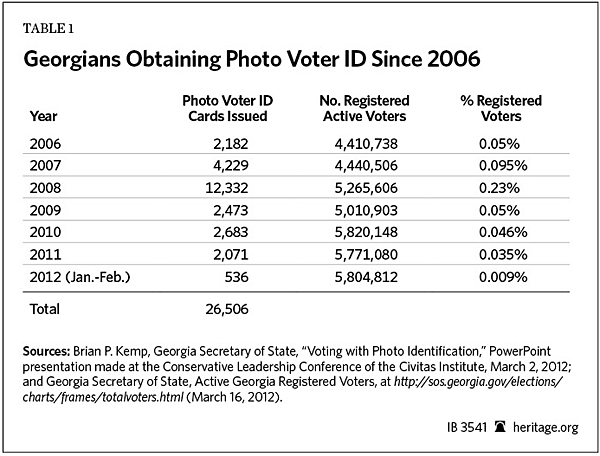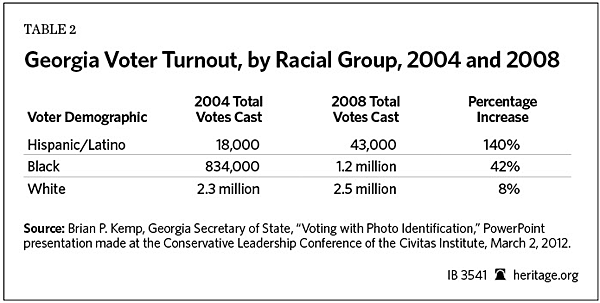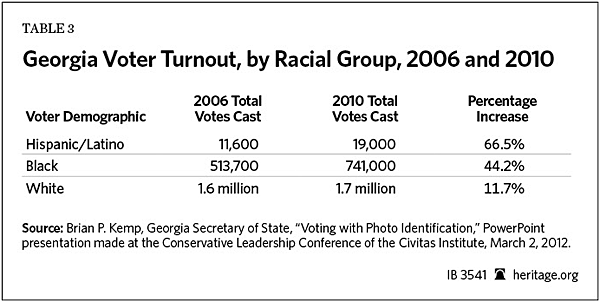The latest data compiled by the Secretary of State of Georgia, Brian Kemp, about the state’s experience with voter ID once again shows that the claims by opponents of voter ID are wrong.
Contrary to their assertions that there are large numbers of American voters without a government-issued photo ID, Georgia has had to issue a remarkably small number of IDs to individuals who did not already have one. The state’s specific turnout data on racial minorities also shows that the claim that voter ID will “suppress” their vote lacks any foundation in facts.[1]
Georgia’s Experience
In 2007, Georgia began requiring voters who cast their ballots in person to present one of six forms of acceptable photo ID. The law was precleared by the U.S. Department of Justice after it found that the law was not discriminatory and met the applicable legal standard under Section 5 of the Voting Rights Act of 1965.[2]
The acceptable forms of ID include:
- A Georgia driver’s license, even if expired, or a Georgia photo voter ID card;
- Any state or federal government-issued photo ID (which includes a student ID issued by the Georgia state college system);
- A U.S. passport;
- An employee photo ID from any branch or department of the federal government or Georgia state or local government;
- A U.S. military photo ID; or
- A tribal photo ID.
Not only did Georgia provide an extensive education program to make voters aware of the photo ID requirement, but the new law also provided a free photo ID to any voter who needed one that could be obtained from their local county voter registrar or the Georgia Department of Driver Services. In fact, the state conducted a statewide, multimedia education campaign prior to six elections between September 2007 and the November 2008 general election. That included sending out over 5 million pieces of direct mail and utility bill inserts to individual voters, as well as 633 packages of 57,000 brochures and other materials to chambers of commerce, churches, libraries, and other nongovernment organizations all over the state.
The state also ran over 60,000 radio public service announcements (PSAs) and 1,232 video PSAs that ran during newscasts, traffic reports, and Atlanta Braves games. Home games of the Atlanta Falcons football team even featured end-zone-to-end-zone LED banners directing fans to the state’s website for more information on the voter ID requirement, and 400 ads were placed on buses operated by the Metropolitan Atlanta Rapid Transit Authority.
It must be kept in mind that when the ACLU, the NAACP, and other organizations filed their ultimately unsuccessful suit in federal court against Georgia over its new photo ID law, one of their specious claims was that “a large number of Georgia voters lack acceptable Photo ID.” The federal judge ultimately dismissed the lawsuit in part because the plaintiffs were unable to provide any evidence to substantiate those claims or “uncover anyone ‘who can attest to the fact that he/she will be prevented from voting’” by the photo ID requirement.[3] Nonetheless, opponents of voter ID continue to claim that there are large numbers of Americans who lack a photo ID.
So how many Georgians have gone to the state to obtain a photo voter ID card because they did not already have a driver’s license or one of the other types of photo ID card acceptable under Georgia law to vote? Over the six years that the voter ID law has been in place, the state has issued a grand total of only 26,506 voter ID cards. The information reported by the Secretary of State shows the following:

The number of photo IDs issued by Georgia to individuals who did not already have one of the forms of ID acceptable under state law is remarkably small, averaging less 0.05 percent in most years, and not even reaching three-tenths of 1 percent in a presidential election year. Georgia’s actual experience matches other data, such as a survey conducted by American University of registered voters in Maryland, Indiana, and Mississippi. It found that less than 0.5 percent of respondents had neither a photo ID nor citizenship documentation.[4] A 2008 election survey of 12,000 registered voters in all 50 states found fewer than nine people who were unable to vote because of voter ID requirements.[5] This completely contradicts the unsupported claims of voter ID opponents that there are hundreds of thousands of voters in every state who do not have a photo ID or the claims of the Brennan Center that “as many as 11% of United States citizens…do not have government-issued photo IDs.”[6]
Georgia’s experience with minority voters also directly refutes the claims that voter ID laws somehow prevent racial minorities from voting. Keep in mind that Georgia’s photo ID requirement was not in place in the 2004 presidential election or the 2006 mid-term congressional elections. The law was first effective in the 2008 presidential election and the 2010 congressional elections, although Georgia has actually had at least 40 state and federal elections since September 2007 when the law became effective, not including municipal and county elections. More than 15 million votes have been cast in those elections.
According to the Secretary of State, the turnout of black and Hispanic voters has been as follows:

The increase in turnout of both Hispanics and blacks in the 2008 presidential election after the voter ID law became effective is quite remarkable, particularly given the unproven and totally speculative claims of the Justice Department that the voter ID requirements of Texas and South Carolina will somehow have a discriminatory impact on Hispanic and black voters.[7] In fact, Georgia had the largest turnout of minority voters in its history.
Georgia had the same exemplary experience in the 2010 congressional election[8]:

The large increase in turnout of Hispanic and black voters in the 2008 and 2010 federal elections far outpaced the growth rate of those populations in Georgia over a 10-year period. The U.S. Census reports that from 2000 to 2010, the Hispanic population in the state grew 96.1 percent while the black population grew by only 25.6 percent.[9]
A Common-Sense Reform
In both federal elections held in Georgia since its voter ID became effective, the increase in turnout of Hispanic and black voters dwarfed the increase in turnout of white voters. As shown by these data—as well as the fact that federal and state courts in Georgia dismissed lawsuits filed against the Georgia voter ID law that had claimed it was both unconstitutional and discriminatory—voter ID requirements can be easily met by almost all voters and do not have a discriminatory or disparate impact on racial minorities. Georgia’s experience also shows that the number of voters who do not already have an acceptable photo ID is very small.
Requiring photo IDs is a common-sense election reform. The latest Rasmussen polling shows that it is supported by 72 percent of likely voters.[10] The Justice Department and other outspoken opponents of voter ID should stop standing in the way and allow states to implement reasonable and demonstrably nondiscriminatory laws that are intended to ensure the integrity and security of the election process.
Hans A. von Spakovsky is a Senior Legal Fellow in the Center for Legal & Judicial Studies at The Heritage Foundation. He is a former Commissioner on the Federal Election Commission and the former Counsel to the Assistant Attorney General for Civil Rights at the U.S. Department of Justice.
